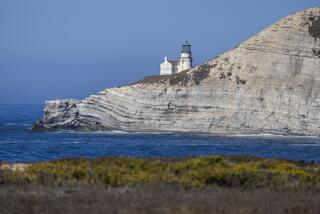Channel Islands to Inventory All Species : Research: The park will receive an extra $622,000. It will monitor marine life for 10 years under a national program.
Channel Islands National Park will receive an extra $622,000 over the next two years, which will allow researchers for the first time to compile an inventory of all species of plants and animals in the park and then monitor them for 10 years.
The park is one of four in the nation chosen to conduct similar studies, which the National Park Service hopes can be used to develop a blueprint for programs at 250 parks nationwide.
The five-island park contains more than 2,000 species of plants and animals--some of which are not found anywhere else in the world--and has been lauded by scientists and conservationists for its ongoing efforts to monitor the health of its marine life.
With the additional funding--$320,000 this year and $302,000 next year--officials plan to widen the scope of their survey to the plant life found on the off-shore islands.
Park officials say expanding the inventory program is critical if they are to realize their goal of restoring the islands to the condition that they were in before settlers arrived in the 19th Century.
The new survey is to include an analysis of efforts to eradicate a large colony of feral pigs on Santa Rosa Island and to rid the islands of plants such as ivy. The pigs and many plant species were brought to the islands from the mainland.
“Inventory and resource-monitoring programs are incredibly important in today’s world” because of encroachment on natural environments, Channel Islands Park Supt. Mack Shaver said.
“It’s really hard to protect an ecosystem if you don’t even know what’s there,” Shaver said.
For years, researchers have dived into the thick kelp forests around San Miguel Island, where they counted fish and crustaceans and monitored plant growth; waded through tide pools in the park to measure black abalone, an overfished species that almost disappeared, and studied the habits of seals and sea lions off the coast of Anacapa Island during winter.
The areas to be studied on shore are much larger than in the marine environment, so the team of researchers, scientists and administrators has divided the park into 14 categories, 10 of which are on land, Shaver said.
Researchers plan to monitor the effects of grazing, drought and accelerated erosion on plant communities, said Gary Davis, a park research scientist. “Then there are areas that had pigs on them, or areas that are no longer grazed.
“We need to then look at our restoration efforts and evaluate the effect the changes had,” said Davis, who spent a decade designing parts of the resource-monitoring program.
Davis said the research team, which will add seven employees because of the new funding, eventually will have much the same relationship as a doctor and patient.
“As physicians, we monitor the park’s health, then prescribe fitness measures, and, when needed, we give treatment,” Davis said.
“If we’re doing a checkup and find out that there are fewer Torrey pines on Santa Rosa than there should be, or less sea birds, then we’ll know there’s a problem to be dealt with.”
Shaver said the kind of information learned during the new study will allow park rangers to explain more of the area’s features.
“We’ll be able to tell visitors what the natural conditions are, what threats to the ecosystem exist and a lot more about restoration and protective measures,” he said.
Along with Channel Islands, Alaska’s Denali National Park, the Great Smoky Mountains National Park in Tennessee and North Carolina, and Virginia’s Shenandoah National Park were chosen for the program, said Dennis Fenn, deputy associate director for natural resources for the Park Service.
The parks were selected for the additional research because they already had inventory and monitoring programs under way, Fenn added.
The four-park pilot program is being funded through a $1.9-million congressional grant, Fenn said, adding that it would cost about $200 million a year to implement similar programs at the 250 parks nationwide.
Fenn said it is unlikely that Congress would allocate that much money at one time. He said it is more likely that the Park Service will get enough funding to conduct only inventories at all the parks, which would cost $25 million over 10 years.
More to Read
Sign up for Essential California
The most important California stories and recommendations in your inbox every morning.
You may occasionally receive promotional content from the Los Angeles Times.










